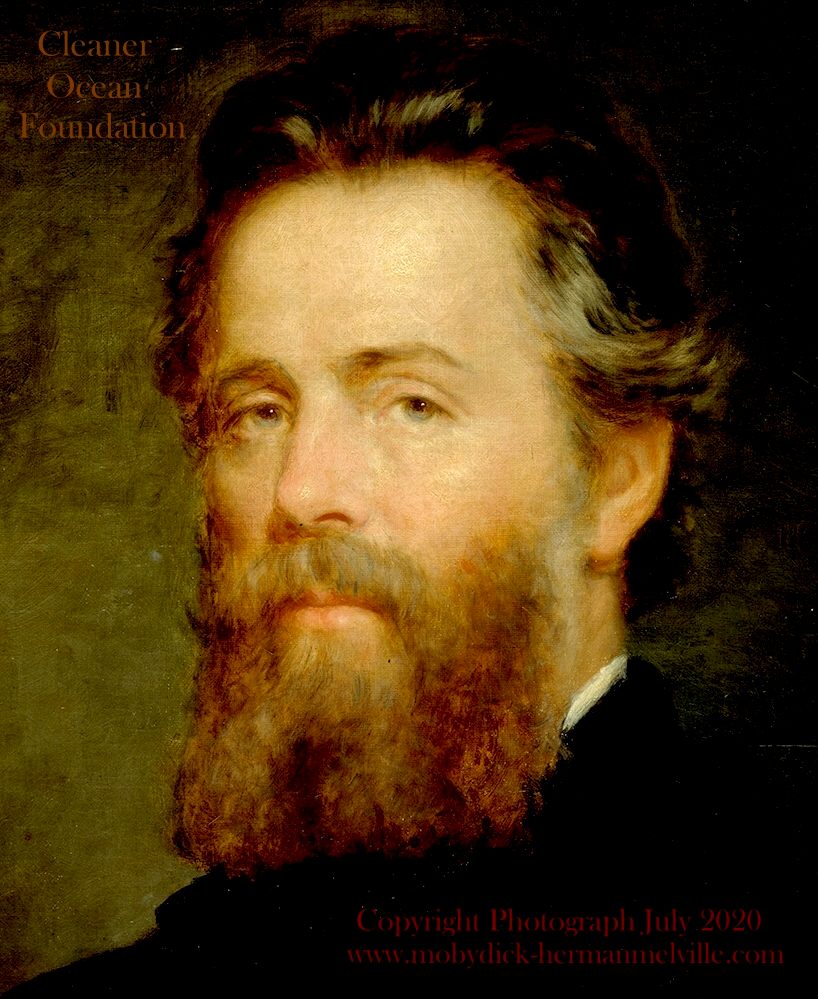
Herman
Melville was the author of a novel abut what we'd now consider an illegal
activity;
the commercial hunting of whales for oil and meat. In capturing the
whaling industry at its peak, showcasing the rebellious white whale, in
our view he was lobbying for the whales, the innocent victims in his
story. Following his death in New York City in 1891, he posthumously came to be regarded as one of the great American writers.
Herman Melville was born
in New York City on the 1st of August 1819. He died on the 28th of September 1891. He was an American novelist, short story writer and poet of the American Renaissance period. Among his best-known works are Moby-Dick (1851), Typee (1846), a romanticized account of his experiences in Polynesia, and Billy Budd, Sailor, a posthumously published novella.
The centennial of his birth in 1919 was the starting point of a Melville revival,
when Moby-Dick began to be considered one of the great American novels.
WHITE
JACKET
White-Jacket; or, The World in a Man-of-War is the fifth book by
the American writer, first published in London in 1850. The book is based on the author's fourteen months' service in the United States Navy, aboard the frigate USS Neversink (actually USS United States).
Based on Melville's experiences as a common seaman aboard the frigate USS United States from 1843 to 1844 and stories that other sailors told him, the novel is severely critical of virtually every aspect of American naval life and thus qualifies as Melville's most politically strident work. At the time, though, the one thing that journalists and politicians focused on in the novel was its graphic descriptions of flogging and the horrors caused by its arbitrary use; in fact, because Harper & Bros. made sure the book got into the hands of every member of Congress, White-Jacket was instrumental in abolishing flogging in the U.S. Navy forever. Melville scholars also acknowledge the huge number of parallels between White-Jacket and Billy Budd and view the former as a rich source for possible interpretations of the latter.
The novel takes its title from the outer garment that the eponymous main character fashions for himself on board ship, with materials at hand, being in need of a coat sufficient for the rounding of
Cape
Horn. Due to a ship-wide rationing of tar, however, White-Jacket is forever denied his wish to tar the exterior of his coat and thus waterproof it. This causes him to have two near-death experiences, once when he is reclining among the canvases in the main-top and, his jacket blending in with the surrounding material, he is nearly unfurled along with the main sail; and once when, having been pitched overboard while reeving the halyards, he has to cut himself free from the coat in order not to drown. He having done so, his shipmates mistake the discarded jacket for a great white shark and harpoon it, sending it to a watery grave.
The symbolism of the color white, introduced in this novel in the form of the narrator's jacket, is more fully expanded upon in
Moby-Dick, where it becomes an all-encompassing "blankness". The mixture of journalism, history, and fiction; the presentation of a sequence of striking characters; the metaphor of a sailing ship as the world in miniature—all of these prefigure his next novel, Moby-Dick.
Many of the enlisted crew became figures in White-Jacket. Foremost among them is Melville's hero Jack Chase, captain of the maintop, in reality Englishman John J. Chase, age 53. Chase had fought at the Battle of Navarino and deserted USS St. Louis to fight for Peruvian independence. The log confirms Chase returned to the frigate on 29 May 1842 and his pardon at the request of the Peruvian ambassador for his services to the government of Peru.
Another character is the ship purser (Edward Fitzgerald) and like many naval officers a slaveholder. In October 1841 with the written consent of the Secretary of the Navy, purser Fitzgerald entered his "servant" (slave) Robert Lucas as a landsman (in reality his personal steward) as a crew member and collected Lucas nine dollar per month wages. In the novel White-Jacket, Lucas becomes "Guinea" the body servant, the only person aboard except the hospital steward and the invalids exempt from being present at muster for punishment.
White-Jacket was published in London by Richard Bentley on February 1, 1850, and in New York by Harper & Brothers on March 21, 1850.[9] Melville referred to it and his previous book Redburn as "two jobs which I have done for money—being forced to it as other men are to sawing wood."
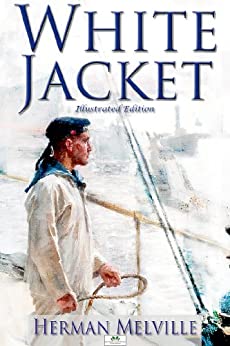
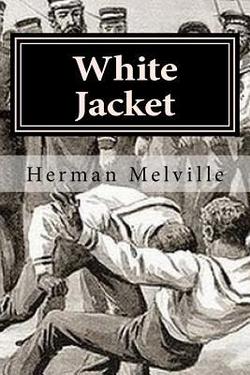
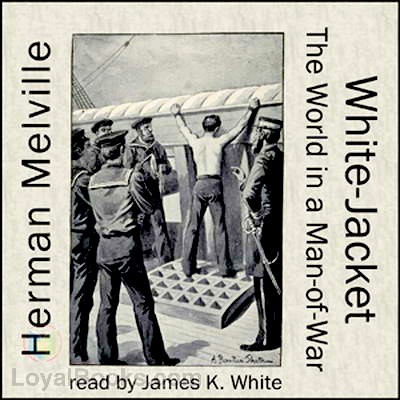
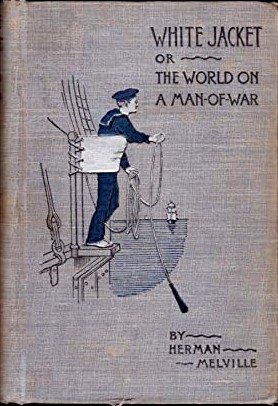
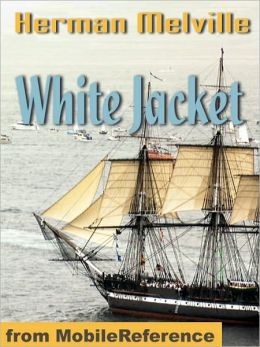
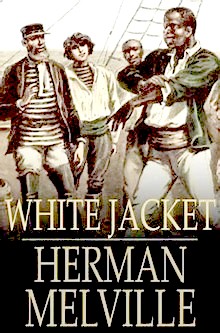
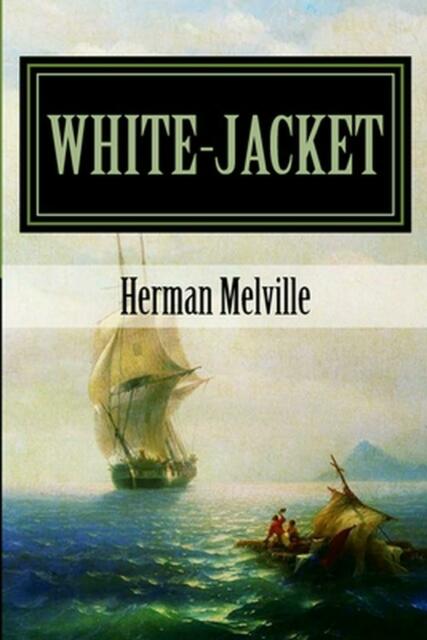
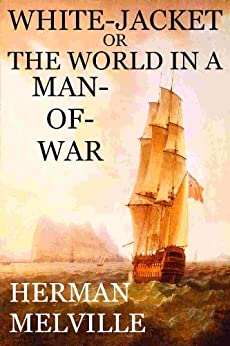

LEGAL IMPACT
At the urging of New Hampshire Senator John P. Hale, whose daughter, Lucy, would later become the fiancée of John Wilkes Booth, the murderer of President Abraham Lincoln, the United States Congress banned flogging on all U.S. ships in September 1850. He was inspired by Melville's "vivid description of flogging, a brutal staple of 19th century naval discipline" in his "novelized memoir" White-Jacket.
The man whom Melville based the fictional commodore on, Thomas ap Catesby Jones, a former commander of USS United States, was brought up on a court-martial in 1850 and found guilty on three counts mostly related to "oppression" of junior officers. Jones was relieved of command for two and a half years. In 1853, President Millard Fillmore reinstated him, and in 1858 the United States Congress restored his pay.
During Melville's time aboard USS United States from 1843–1844, the ship log records 163 floggings, including some on his first and second days (18 and 19 August 1843) aboard the frigate at Honolulu, Oahu. The official log entry for 18 August 1843 simply states, “Commenced with moderate breezes from the Nd & Ed. and clear. Shipped Herman Melville. “O.S.” and Griffith Williams “O.S.” ... at 9 a m . mustered the crew at Quarters, Punished Jno Hall, “O.S” with 12 lashes with cats for striking sentry on Post. Geo Clark “OS” with 12 of cats for smuggling liquor, Bos. C. B. Stanly “App” with 12 lashes with Kittens for fighting and Wm B Ewing “App” with 6. for using provoking language. Suspended the Boatswain from duty for disrespectful - conduct to the Officer of the Deck,- by replying when ordered by same through – Midn [Midshipman] Key, to call all hands stand by their washed clothes “ that he would ‘receive no more orders in this Ship”, or words to that effect.”
The following day 19 August 1843 the log records yet another muster for punishment. "From 8 to meridian, moderate breezes from the Nd & Ed and clear, at 9. hoisted in the 3d Cutter, and got the lower booms alongside. Punished Geo Davis, Wm Stewart and Antonio Guavella “Bandsmen” with 12 lashes each for drunkenness." In “A Flogging”, (chapter 33) Melville, changed this brutal scene from 19 August 1843 in Honolulu Oahu to sometime later when the frigate was at sea. He also changed the names of the crewmen punished to John, Peter, Mark, and Antone and the charge from drunkenness to fighting. “Antone, the Portuguese” is clearly based on his recollection of Antonio Guavella."
CHARACTERS
- White-Jacket, the main character and narrator, so nicknamed because his coat is the only white one on board; a novice sailor (at least on a naval ship), his jacket often gets him into trouble, mostly because of its whiteness
- Jack Chase, a sailor of British origin who is universally regarded by his fellow seamen and even by the officers as the epitome of a true and good sailor; he shows contempt for any man who has shipped out on a whaler
- Captain Claret, a captain of usually severe tendencies, his name reflects the fact that he is also an alcoholic
- Commodore
- Selvagee, a foppish lieutenant whose leadership style is tyrannical
- Mad Jack, a lieutenant whose leadership style is collegial
- Old Coffee, the ship's cook
- Mayday, a ship's cook deputy
- Rosewater, a ship's cook deputy
- Lemsford, a sailor who aspires to be a poet
- Quoin, a sailor "indefatigable in attending to his duties, which consisted in taking care of one division of the guns"
- Nord, a sailor of surly look and melancholy disposition; when White-Jacket first encounters him, the only friend Nord has on board is Lemsford
- Williams
- Wooloo, the commodore's Polynesian servant
- Old Revolver
- Old Combustibles
- Chaplain
- Cuticle, the ship's Surgeon
- Shakings
- Bland, the ship's master-at-arms
- Tawney, a sheet-anchor man, a "staid and sober seamen, very intelligent," whom White-Jacket sometimes invites to join the crew in the main top and tell stories. Tawney is the only black character in the novel to be treated equitably in relation to the other characters.
- Guinea, a slave owned by the ship's purser
- Ushant, a much admired sexagenarian and crew member of the fore top who, along with many other sailors, cultivates a long flowing beard or "homebounder." When Captain Claret commands all facial hair be shorn to meet Navy regulations, a small rebellion ensues but ultimately Ushant is the sole remaining dissenter. He is flogged, put in chains, and held in the brig for weeks, but arrives in Norfolk harbor with his beard intact and a hero among his peers. White-Jacket takes a hair from Ushant's beard as a memento.
- Emperor Don Pedro II
MOBY
DICK - OUR FAVOURITE
Herman
Melville's Moby
Dick, is the story of a great white sperm whale that fought back at
whalers who tried to harpoon him. The idea came to Herman Melville after
he spent time on a commercial whaler, where stories abounded of the
sinking of the Essex in 1821 and Mocha
Dick, a giant sperm whale that sank around 20 ships, before being
harpooned in 1838.
LINKS
& REFERENCE
https://melvillesociety.org/
http://melville.org/
Please use our
A-Z INDEX to
navigate this site









